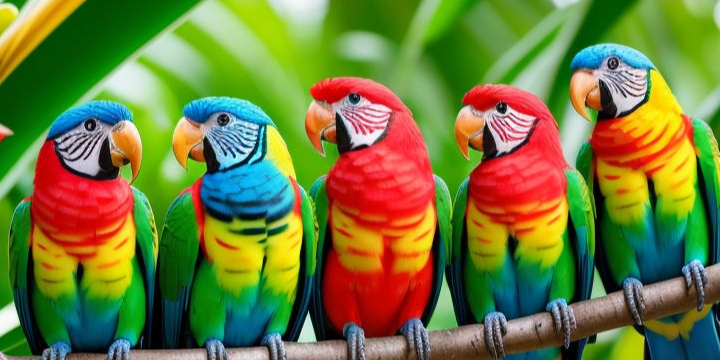Kohanga (koˈhaŋa)
"It's an obscure language from a tiny island, far from any trade routes worth mentioning. If it weren't for the parrots, I doubt anyone would ever have heard of it at all."
Kohanga is the language of the Kohangan people of Te Kohanga, a small island south of Motu. It is closely related to Gagana, and is inspired by Tokelauan. Despite its remote origins, a surprising number of sailors know a little of it, and it has had significant influence on the Common Tongue.
Dialects
The island of Te Kohanga only has about five hundred Kohangan inhabitants, spread out among three small communities. This has not left much room for dialects to develop. The closest thing is the version of the language spoken by sailors who have learned it from the Kohangan Parrots they befriend. In total, there are more parrots who speak Kohanga than actual Kohangans, and there may be more sailors too.
Interesting Features
The most interesting thing about Kohanga is the population of Kohangan Parrots who speak it natively. These birds have been blessed by the god of Te Kohanga, Manu'aku. They have the ability to speak Kohanga, and can easily learn new languages as well. Kohangan Parrots are sought after by merchants and sailors as translaters, and many outsiders have learned a little Kohanga specifically to negotiate with the parrots.
Related Languages
Kohanga is closely related to Gagana, the language of the Mu'o'a of Motu. Gagana and Kohanga are mutually intelligible, and differ mainly in accent, idiom, and some vocabulary.
Naming Traditions
Kohangan names have two parts. The first part of the name represents the kāiga, or nest that the person was hatched in. This does not change during their lifetime, and it is strictly forbidden to procreate with someone from your own kāiga. There are only three kāiga of Kohangans on the island, which leads them to sometimes visit Motu to mingle with the Mu'o'a of the larger island.
The second part of a Kohangan name is the personal name. This name can change frequently during a person's life, and is treated more like a nickname than anything else. Frequently, the personal name will be bestowed in childhood by the person's friends, and these hatchling names often persist throughout the person's life, unless they receive a different nickname that becomes more popular. It is not uncommon for an individual to have multiple personal names they respond to, depending on who is addressing them. Like in most Kikipua cultures, personal names in Kohanga are not gendered.
Writing System
Kohanga does not have a native writing system. In the cases where something needs to be written down, the writer will use whichever writing system they feel is best.
Geographical Distribution
Kohanga is spoken on the island of Te Kohanga, and by various sailors who have learned it to communicate with the Kohangan Parrot. It is not well known elsewhere.
- Mālo ni! – Greetings!
- Tofa ni – Goodbye
- Fa'afetai – Thank you
- 'Aua e manatu ai – You’re welcome
- Fesoasoani mai! – Help!
- Fakālogo mai – Please
- O fea le fale? – Where is the village?
- E fia le tau? – How much does it cost?
- Ua leiloa a'u – I am lost
- O le fa'amālō! – Look out!
- Lalu – Playful and light-hearted, often given to mischievous children.
- Puku – Meaning "soft" or "round," often used affectionately for someone gentle.
- Namu – Inspired by the word for "mosquito," given to someone quick or buzzing with energy.
- Kipi – Meaning "whirl," for someone lively or prone to stirring things up.
- Tama – Meaning "bright," for someone cheerful or clever.
- Huna – Meaning "hidden," for someone mysterious or reserved.
- Viti – Meaning "spark," for someone who inspires or energizes others.
- Ona – Meaning "wave," for someone calm yet powerful.
- Mala – Meaning "garden," for someone nurturing or creative.
- Lopo – Meaning "cliff," for someone steadfast and reliable.
- Te Hau
- Te Moana
- Te One
Related Articles
This article was originally written for Spooktober 2024. You can find all of my Spooktober Articles at Spooktober Central.
This article was originally written for Spooktober 2023. You can find all of my Spooktober Articles at Spooktober Central.




This is beautiful! I love how the parrots can teach sailors this language- great touch!
Thanks!